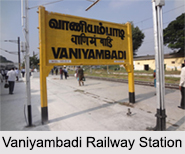 Located in the Vellore district of the Indian state of Tamil Nadu, Vaniyambadi is a town and a municipality situated at 12.68 degree north 78.62 degree east. The town is positioned at an elevation of 363 m and is situated on the banks of the Palar River. There are two lofty hills, Yelagiri and Javadi Hills which are located on the southern direction of the town.
Located in the Vellore district of the Indian state of Tamil Nadu, Vaniyambadi is a town and a municipality situated at 12.68 degree north 78.62 degree east. The town is positioned at an elevation of 363 m and is situated on the banks of the Palar River. There are two lofty hills, Yelagiri and Javadi Hills which are located on the southern direction of the town.
Legend of Vaniyambadi
It is believed that the name Vaniyambadi has been derived from the name `Vani` and `Badi.` Vani is the name of Hindu Goddess Saraswati and `Badi` means to sing folklore. It is believed that at the requests of Lord Vishnu and Lord Shiva Vani sang folklores on the banks of Palar River. There are temples for Athitheeswarar (Shiva) with Prahannaayagee and Sundara Varadaraja Perumal (Vishnu) on both sides of the river. The temple was built in the 12th century.
Economy of Vaniyambadi
Leather tanning forms a major industry for Vaniyambadi. The town is known for trading in leather with global countries. It mainly deals in leather jacket and leather gloves. The major source of livelihood for the people residing in the town of Vaniyambadi is agriculture, especially coconut plantations.
The major population of Vaniyambadi mainly comprises of followers of Hinduism, Christianity, Islam and Jainism. The main language spoken here is Tamil language while the Muslims speak Urdu language. Telugu language and Kannada language are also spoken here. Some of the important festivals celebrated in Vaniyambadi are Diwali, Pongal, Bakri Id, Ramadhan and Christmas.
 Demography of Vaniyambadi
Demography of Vaniyambadi
According to the reports of Census India 2011, Vaniyambadi had a population of 195,061 with a sex-ratio of 1,023 females for every 1,000 males, much above the national average of 929. Children between the ages of 0 to 6 years are 12,013 constituting of about 6,121 males and 5,892 females. The average literacy of the town was 74.37 percent, compared to the national average of 73 percent. With a total of 20559 households, the town of Vaniyambadi had a total of 31,013 workers, comprising 94 cultivators, 218 main agricultural labourers, 800 in household industries, 26,529 other workers, 3,372 marginal workers, 11 marginal cultivators, 100 marginal agricultural labourers, 202 marginal workers in household industries and 3,059 other marginal workers.
Tourist Places in Vaniyambadi
Yelagiri, the famous hill station is almost 25 km away from the town of Vaniyambadi. Javadi Hills is another small hill station nearby. Another major tourist attraction is Asia`s second largest telescope, the Vainu Bappu Observatory of the Indian Institute of Astrophysics which is situated at the Kavalur Village near Vaniyambadi. The temples of Sundara Varadaraja (Azhagu) Perumal and Athitheeswarar are several centuries old ancient temples which are located here. Several mosques of modern and ancient architecture are also located here. A Dargah of Janab Masthan Ali Aulia Saheb can be seen here.
Educational Institutions of Vaniyambadi
Establishment of several schools and colleges has been done for the spread of education among the students of Vaniyambadi. Some of the important schools and colleges of the town are Islamiah Boys` Higher Secondary School, Khaderia Higher Secondary School, Khaderia Girls Primary School, Madarsa e Niswan, Madarsa e Azam, Islamiah College, Islamiah Industrial Training Institute, Islamiah Women`s College and Islamiah Girls` Higher Secondary School.
Visiting Information on Vaniyambadi
Vaniyambadi is well connected with all modes of transport. The town is connected with all the important roadways and railways of the major cities of India. The city of Chennai is located at a distance of 199 km and Bengaluru is located at a distance of 144 km from Vaniyambadi. Vellore is situated almost 64 km away and Salem is located almost 139 kms away from the town. Vaniyambadi lies on the National Highway 46 of the Bengaluru-Chennai section. A railway station of the Chennai-Bengaluru and Chennai-Salem section is also located here.



















